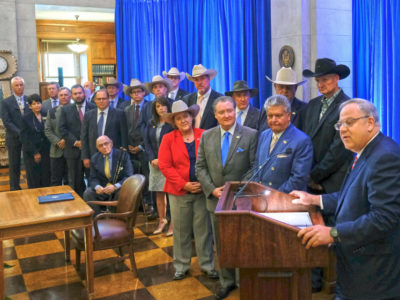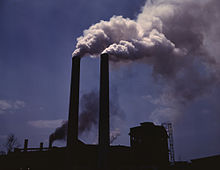Regulatory Policy
Cost-Benefit Analysis and the Next President
If it’s Trump, we’ll see more of the same. But what if a Democrat wins?
Under executive orders dating back to Reagan, regulatory agencies like EPA are supposed to follow cost-benefit analysis in making decisions. Under the Trump Administration, however, cost-benefit analysis has barely even served as window-dressing for its deregulatory actions. It has launched a series of efforts to prevent full counting of regulatory benefits, as well as committing …
Continue reading “Cost-Benefit Analysis and the Next President”
CONTINUE READINGAnd the Survey Says…
How to interpret and utilize “environmentalist” poll results showing widespread support for environmental protection
As most of us know by now, environmentalism in the United States has increasingly become a politically polarizing topic. A Gallup poll from March 2018 revealed that only 42% of surveyed individuals consider themselves to be “environmentalists,” a figure which has decreased over time from the early 1990s: Interestingly, however, this shift in identity for …
Continue reading “And the Survey Says…”
CONTINUE READINGAnti-Science Climate Denialists Must Be Behind the Methane Rollback
Reducing Methane is a Really Smart Climate Solution With Fast Results
Dan and Ken have offered quick takes on why the latest Trump assault on the environment is inexplicable — as they note, the oil industry doesn’t need or want a rollback of rules that regulate methane emissions, and the compliance costs to industry are tiny. So what is the point of gutting a rule to …
Continue reading “Anti-Science Climate Denialists Must Be Behind the Methane Rollback”
CONTINUE READINGConference on the Ocean’s Role in Sustainable Food Production
U.C. Davis Will Host Cutting-Edge Event on September 16-17, 2019
U.C. Davis’ Coastal and Marine Sciences Institute, in conjunction with the UCD School of Law’s California Environmental Law & Policy Center, will host an important and timely conference on September 16-17, 2019. “The Ocean’s Role in Sustainable Food Production” will offer an in-depth, interdisciplinary look at current scientific, economic, social, legal and governance issues surrounding …
Continue reading “Conference on the Ocean’s Role in Sustainable Food Production”
CONTINUE READINGPrinciples of Climate Governance
We need to address the procedures and structures for climate policymaking.
There’s a lot of discussion about the substance of climate policy today. That’s obviously critical, but we also need to think about the procedural and institutional issues involved in making climate policy. For instance, we need to think about how to divide authority between the states and the federal government. I thought it would be …
Continue reading “Principles of Climate Governance”
CONTINUE READINGTrump Administration Attempts to Eviscerate the Endangered Species Act
Rather Than “Improve” ESA, Newly-Adopted Regulations Dramatically Erode Its Historic Protections
The Endangered Species Act, enacted in 1973, has for most of its history been the most controversial and politically-charged of all the foundational environmental laws adopted by Congress in the 1970’s. But despite its contentious history, opponents of the ESA have been unsuccessful in their efforts to weaken the law, either through significant Congressional amendments …
Continue reading “Trump Administration Attempts to Eviscerate the Endangered Species Act”
CONTINUE READINGElections Matter – Even More Than You Thought.
Three ultra-close elections put us a dozen years behind in climate policy.
I don’t know about you, but I’m finding it hard to keep focused on November 3, 2020, given the confusing welter of candidates on one side and the daily bombshells issuing from the other. So maybe this is a good time for a reminder of a why elections matter. In fact, they not only matter, …
Continue reading “Elections Matter – Even More Than You Thought.”
CONTINUE READINGGet Ready for Phase 2 of the Deregulation Wars
Air quality standards are next on the chopping block.
The first phase of Trump’s regulatory rollbacks has been directed against Obama’s climate change regulations. Those deregulatory actions will be finalized soon. What happens next will be in the hands of the courts. But the Trump EPA is now beginning a new phase in its attack on environmental regulation. Having tried to eliminate climate rregulation, …
Continue reading “Get Ready for Phase 2 of the Deregulation Wars”
CONTINUE READINGPerfection – Public Enemy Number One, or Straw Man?
We don’t let the perfect be the enemy of the good. Is that always a good thing?
“Don’t let the perfect be the enemy of the good.” How many times do you think you have heard that phrase? Many people attribute the concept to Voltaire, so as advice goes, how bad could it be? It’s darn good advice in many situations – such as selecting a checkout line to stand in at …
Continue reading “Perfection – Public Enemy Number One, or Straw Man?”
CONTINUE READINGThe Flight of the Bumblebee
The Trump Administration loses an environmental case. Again.
Last Friday, the Fourth Circuit halted efforts to build a natural gas pipeline because the Administration had done such a lousy job of showing its compliance with the Endangered Species Act. This was one of the Administration’s many losses in court. The case involved a perfect example of “arbitrary and capricious” decision making, to use …
Continue reading “The Flight of the Bumblebee”
CONTINUE READING










